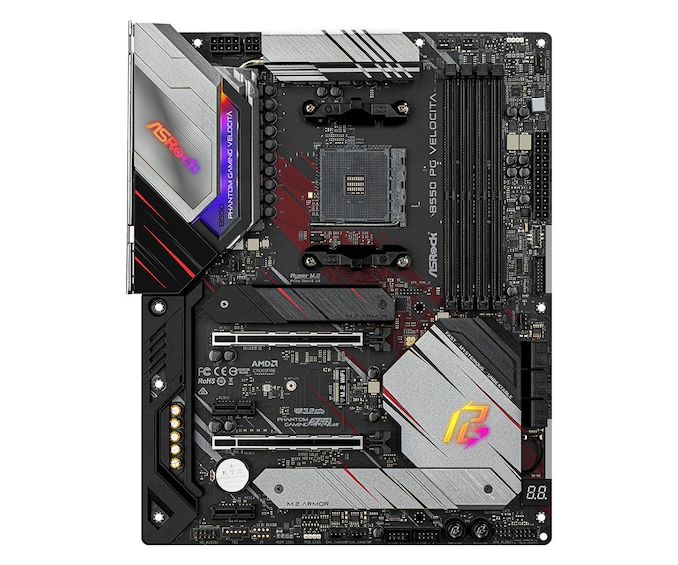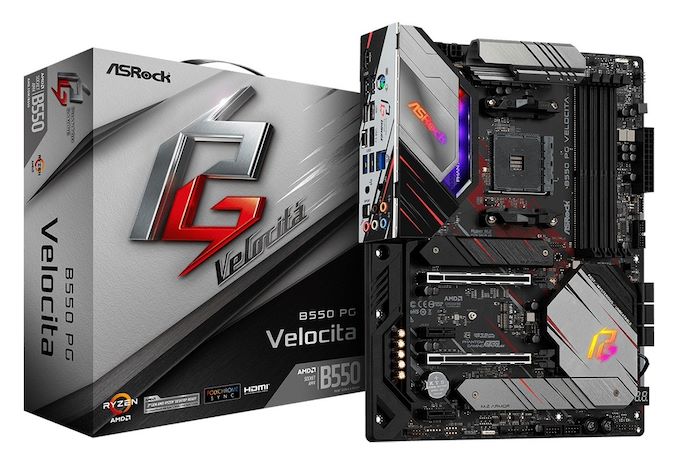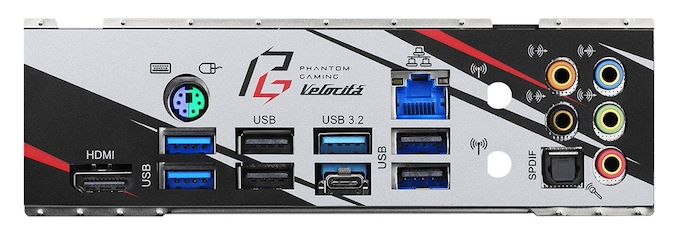The AMD B550 Motherboard Overview: ASUS, GIGABYTE, MSI, ASRock, and Others
by Dr. Ian Cutress & Gavin Bonshor on June 16, 2020 11:00 AM ESTASRock B550 PG Velocitá
The new Velocitá branding from ASRock, as started on Z490, is an attempt to define a high-end motherboard based on speed, but also style, hence the name ‘Velocitá’. In previous incarnations, ASRock motherboards would often show pictures of high performance sports cars that eerily looked very close to the popular Lamborghini of the day, but those boards were focused on overclocking. This time Velocitá is more about the gaming, hence it falls under the Phantom Gaming family.
The PG Velocitá is a relatively clean board to look at, with the main style focused on a 45-degree downward slope from left to right, and a number of jagged edges on decals around the motherboard. As we can see, there is also some element of RGB here, on the chipset heatsink and on top of the rear panel. There is also a pair of onboard RGB headers at different ends of the board.
The power delivery heatsinks in the Velocitá are connected via a heatpipe, hiding a 12+2 phase design indicative of which market ASRock wants to push this product. Powering the CPU is an 8-pin and a 4-pin, while the socket area has access to five 4-pin fan headers within easy reach.
Down the right side of the motherboard is a Type-C front header, a USB 3.0 front header, six SATA ports from the chipset, and a two digit debug. Along the bottom are more fan headers, two USB 2.0 headers, power/reset buttons, and a front panel connector.
For the PCIe layout, the top full-length slot is a PCIe 4.0 x16 slot from the CPU, while the second full-length slot is a PCIe 3.0 x4 from the chipset. Surprisingly both of these have additional reinforcement. There is also a PCIe 4.0 x4 M.2 slot above the top PCIe slot for the main M.2 drive, and ASRock puts another PCIe 3.0 x2 M.2 slot on the bottom of the motherboard, and this heatsink is connected to the chipset heatsink.
The audio on the right of the motherboard is an enhanced Realtek ALC1220 design, featuring an NE5532 amp.
The rear panel gives the user a HDMI port, a combination PS/2 port, two USB 3.2 Gen 1 ports, four USB 2.0 ports, a Type-A USB 3.2 Gen 2 port, a Type-C USB 3.2 Gen 2 port, a Realtek RTL8125BG 2.5 gigabit Ethernet port, space for an add-in Wi-Fi antenna output, and the audio jacks.













101 Comments
View All Comments
kpb321 - Tuesday, June 16, 2020 - link
I'm kinda disappointed they ended up missing the opportunity to go PCI-E 4 for the CPU to GPU link. With 2 10gbs USB ports, 2 5gbs USB ports, 10 flexible PCI-E lanes that can be NVME/ Sata ports or add on controllers on the chipset there's plenty of bandwidth there to be bottlenecked by a 4x PCI-E 3 link to the CPU. Going PCI-E 4 would make this somewhat less of a bottleneck and could support for example 2 NVME PCI-E 3.0 4X drives at full speed. The B350 more balanced in this way but sadly it was because the PCI-E off the chipset was only PCI-E 2. Hanging 16x lanes worth of things off a 4x link isn't great when they could have doubled that link bandwidth pretty easily.kpb321 - Tuesday, June 16, 2020 - link
Edit 'm kinda disappointed they ended up missing the opportunity to go PCI-E 4 for the CPU to chipset linkIrata - Tuesday, June 16, 2020 - link
That‘s X570. If you need the additional storage bandwidth, this is what you should go for.Alternatively there is the Aorus board that offers the 8x CPU plus 2x 4x PCIe 4 lanes for nVMe drives plus the PCIe 3 lanes from the chipset. That could be an alternative and eight PCIe 4 lanes for the GPU should be fine with the next gen GPU, except perhaps for the top of the line models.
On the plus side, with Ryzen you have four dedicated PCIe lanes from the CPU for nVMe (16+4+4 vs. 16+4 on Intel).
kpb321 - Tuesday, June 16, 2020 - link
The X570 goes whole hog on PCI-E 4 with PCI-4 hanging off the chipset too and it supports more PCI-E and SATA and USB devices hanging off the chipset so while the CPU to Chipset bandwidth is higher it's actually even more imbalanced between the combine possible bandwidth of devices possible off the chipset and the CPU to Chipset bandwidth.Going PCI-E 4 for just the CPU to Chipset on the B550 would have given the option to decrease that imbalance and one PCI-E 4x link shouldn't have driven the power up too high.
romrunning - Tuesday, June 16, 2020 - link
Then most people wouldn't buy X570 and get B550 instead as there wouldn't be much of a difference. That, and having less PCIe 4.0 stuff lowers the power requirements a bit.I personally held off on X570 because I knew I basically only needed the GPU and NVMe drive to be PCIe 4.0 for the most future-proof setup. I figure I'll buy new again when the new AM5 socket is released with Zen 4. Plus, some of the B550 boards have a Type-C front connector, which will go with the new ITX case I'm getting that has one on the front.
PixyMisa - Wednesday, June 17, 2020 - link
Yes, but then you need to add a separate PCIe controller on the chipset to handle just those 4 lanes. The market probably isn't big enough to make it worthwhile.Irata - Tuesday, June 16, 2020 - link
The CPU to GPU link is 16x PCIe 4.0 - that has nothing to do with the chipset.Or did you mean something else?
a5cent - Friday, June 19, 2020 - link
True, but would that not have brought back the requirement for an actively cooled chipset? That definitely contributes to cost, so it makes sense to cut that from the package.Personally, I'm happy that we've finally left PCIe 2.0 behind. Such chipsets still being sold in 2020 is horrific.
Lucky Stripes 99 - Tuesday, June 16, 2020 - link
I was hoping to build several B550 APU mITX systems this week, but the lack of a compatible APU has stopped those plans. AMD's decision regarding to use a prior generation micro-architecture for its APUs in addition to their decision regarding AM4 firmware size limits are really colliding to create a missed opportunity here. If the iGPU in the Comet Lake processors was better, I'd be picking up H460 or Q470 boards right now instead.DigitalFreak - Tuesday, June 16, 2020 - link
My understanding is that the firmware size limit wasn't created by AMD. The motherboard makers could always use firmware chips with a larger capacity. Intel doesn't have this problem since they only support one or two CPU generations per motherboard :-)